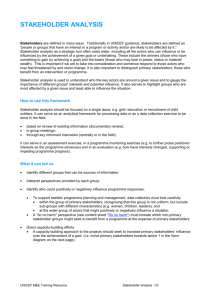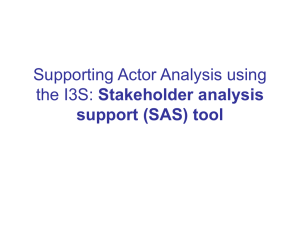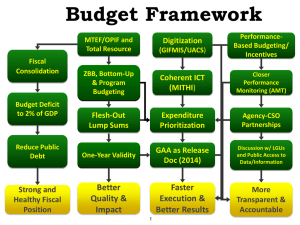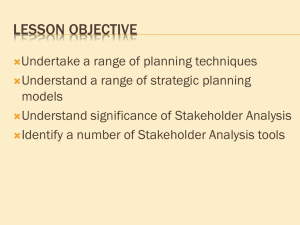Slides
advertisement
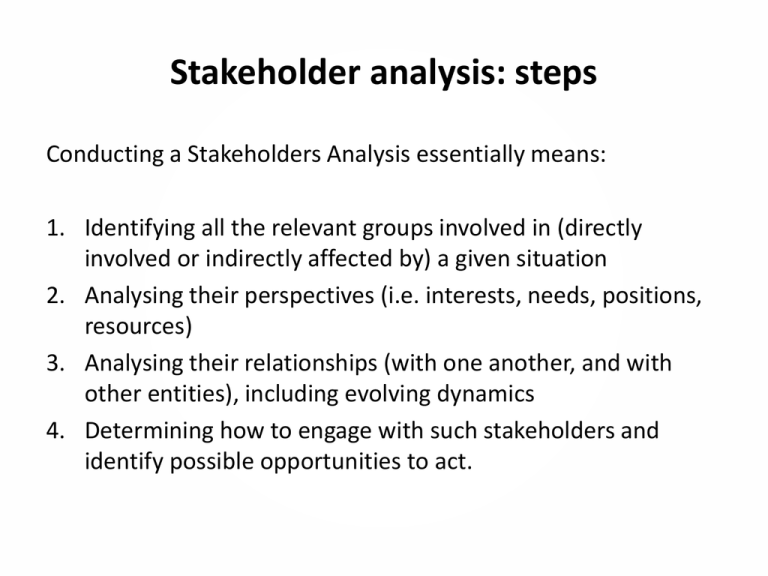
Stakeholder analysis: steps Conducting a Stakeholders Analysis essentially means: 1. Identifying all the relevant groups involved in (directly involved or indirectly affected by) a given situation 2. Analysing their perspectives (i.e. interests, needs, positions, resources) 3. Analysing their relationships (with one another, and with other entities), including evolving dynamics 4. Determining how to engage with such stakeholders and identify possible opportunities to act. Stakeholder analysis: Tools 1. Stakeholder inventory: Mapping out international, national and local actors, i.e. list all relevant actors who can significantly influence or are affected by conflict. 1. Stakeholder profile: analyzing, for each of the stakeholders : – Characteristics: typology or nature of the actor/organization – Interests/needs what interests or needs do they have in relation to the conflict and how do these interests influence the conflict? – Positions: what are the relationships among the various actors? What their positions in the conflict context – Capacities: what resources do they have to influence conflict either positively or negatively? 3. Stakeholder Mapping: understanding relationships and dynamics Example of Stakeholder profile CPN (Maoist) in mid-2000s (Nepal ) Characteristics Interests/Needs • SIZE: About 30.000 militias INTERESTS: Mainly political and 100.000 direct supporters. • Control of state power • Socialist revolution • LOCATION: Rolpa and through violent regime other Western districts in change the hilly regions. • ALLIES: Linkages with Indian Maoist groups • SCOPE: National • MEMBERSHIP: Mixed (voluntary enrolment and targeted abductions) NEEDS: • security - control of the army • Political legitimacy and acceptance by traditional parties • Constituent assembly Positions Capacities • MILITARY: Weapon OFFICIAL POSITIONS supply by Indian • Replacement of Maoists current political elite • Removal of Monarchy • ECONOMIC: resources • Establishment of from informal tax socialist state revenues in areas under • Protection of ethnic control minorities INFORMAL POSITIONS: • SOCIO-POLITICAL: Capacity to influence • Tactical alliance political debate in the possible with either capital and capacity to the Monarchy or disrupt ordinary life traditional political through general strikes parties (Bandha) • Acceptance of democratic republic if • MEDIA: Extensive use of transition process is web and informal media guaranteed and to support their action accepted by India and for proselytism. Stakeholder analysis: tools (cont.) 3. Stakeholder mapping: a visual mapping is useful to understand the relations between different actors (for example those who are allied or opposed, those who have shared interests). Stakeholder analysis exercise 1. Look at the conflict analysis your group developed/your country context 2. List all relevant actors to the situation 3. From the list above, identify 8-10 key relevant stakeholders, including 2-3 relevant for the education sector. 4. Conduct a quick profile of each key stakeholder. 5. Produce a visual map of these stakeholders.





